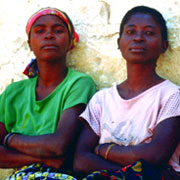World Health Day UNITED NATIONS, April 7, 2006 (Inter Press Service-IPS)—The fight to rid the world of landmines is being won, said U.N. experts on April 4, Landmine Awareness Day, but greater commitment is needed to rebuild the lives of victims, most of whom still lack access to rehabilitative care.
UNITED NATIONS, April 7, 2006 (Inter Press Service-IPS)—The fight to rid the world of landmines is being won, said U.N. experts on April 4, Landmine Awareness Day, but greater commitment is needed to rebuild the lives of victims, most of whom still lack access to rehabilitative care.
More than 80 countries contain buried landmines and other explosive remnants of war, which together kill or maim between 15,000 and 20,000 people annually, according to the Landmine Monitor Report 2005. At least 20 percent of the victims are children, and 80 percent are civilians.
Launched by the U.N. to raise public awareness about landmines and efforts for their eradication, the first International Day for Mine Awareness and Assistance in Mine Action on Apr. 4 brought reason for hope. Thanks to international efforts, the number of mine-affected countries has fallen in recent years, as well as the number of those killed or injured, which hit 26,000 in 1999.
But for thousands of landmine survivors, "Progress is not evident, they don't feel that their daily lives have been significantly altered yet," Cameron Macauley, who has 25 years of experience helping landmine victims, told IPS.
Working with the Landmine Survivors Network (LSN), an international organization created by and for survivors to help victims reclaim their lives, Macauley stressed that the international community must further recognize the needs of survivors in many post-conflict and developing countries.
Only about 10 percent of landmine victims have access to basic health care and rehabilitation. And for those who need sophisticated post-trauma care, the numbers are even lower, according to LSN.
In Ethiopia, for example, there are only two orthopedic surgeons for 71 million people.
"In sub-Saharan Africa, where the problem is at its worst today, many people do not even have information about necessary health care," said Macauley.
"Landmines [also] bring about a nutritional risk, as food security is endangered. If farmers believe that there is a single landmine in an area, that land will be abandoned, crops left un-harvested and food sources will be resultantly scarce," he told IPS..
The fear of mines in the countryside "also forces people to move to overcrowded cities nearby, where they likely become viewed as a burden rather than a workforce," he added.
LSN's institutional advancement director Rachael Galoob Ortega agreed, telling IPS that, "The loss of a limb or the loss of an arm or sight is actually often not [the worst part], but rather the loss of their place in family or in society."
— Excerpts reprinted by permission by Lisa Söderlindh
— Photo: Philip Winslow
|